July 2016
Ready, Set, Go Back to School
A key to nurturing readers is a print-rich environment. The National Early Literacy Panel (click here for report) and the National Association for the Education of Young Children (naeyc.org) recommend immersing children in print, writing tools, signs, and books
Creating a literate environment will also support Common Core State Standards (Reading for Information, Foundational Skills, Writing, Speaking, and Language). As you start preparing your classroom this month, here are a few ideas and activities for planting a reading and writing “garden.” As I always say, “Teachers don’t steal ideas; they harvest ideas.” I’m sure you’ll be able to “harvest” many of these for the age you teach, your students’ interests, skill level, curriculum, and standards.
Skills:
- connection between spoken word and print
- small motor skills
- integration of reading and writing
- alphabet knowledge
- importance of reading and writing; oral language
*Before children read words, they read pictures! By placing pictures and words together, they will begin to make print connections.

Classroom Jobs – Post classroom jobs and children’s assignments.
Labels and Signs – Make meaningful labels with pictures so children know where classroom materials should be stored. Use pictures of objects from school catalogs, pictures from boxes materials come in, or take photographs.
*You might start the year with the word and picture, and then later in the year use a word or sentence.
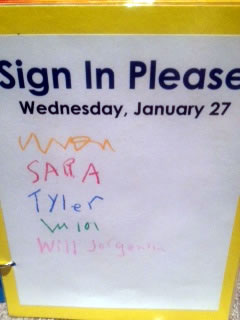
Sign-In Chart – Use a large sheet of paper or a section of your chalkboard for children to sign their name when they enter the classroom every day. Explain, “It’s important for me to know that you are here, so be sure and sign in!”
*Place name cards near the sign in chart so children can use them as models.
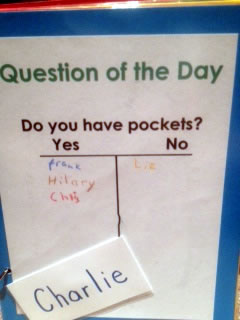
Question of the Day – Write a question on the board each day. Start with simple “yes” or “no” questions where children write their name. Add more choices as the year continues.
Hint! Write children’s names on index cards and attach a strip of magnetic tape to the back. Let them place their name cards to answer questions.

Daily Schedule – Write your daily schedule on a poster board and illustrate it with photos or pictures from school catalogs. Review the schedule every day in sequential order.
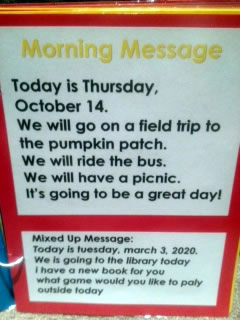
Morning Message – Before children arrive at school, write a message to them on a language experience chart about special events that will happen that day. At circle time, read over the message tracking from left to right. Have children point out letters or words that they recognize.
Hint! Many teachers like to pretend the morning message is from a class mascot (puppet or stuffed animal). This activity not only creates positive feelings about the day, but is also a personal way to reinforce many reading and writing skills.
*As the year progresses make spelling and punctuation errors for the children to correct.
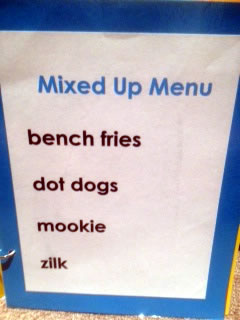
Mixed Up Menu – Write the menu each day, changing a few of the words. For example: “dacaroni and deese, dot dogs, and bilk.” Let the children correct.

Rules – Make a list of classroom rules and review each day. When children are behaving inappropriately, point to the rule as you read and remind them what to do.

Morning Meeting Visuals – Refer to the calendar, days of the week, weather chart, etc. during group time.

Take a Turn – Keep a clipboard or dry erase board by popular centers, games, or books. Children “sign up” for a turn. Demonstrate how to cross through their name to show they have had a turn.

Pocket Chart – Write words to poems or nursery rhymes on sentence strips and put them in a pocket chart. Track the words as you say the rhyme. Let children “be the teacher” and point to the words. Mix up the lines and have children up and unscramble them.
*Write the title and draw a picture clue for different songs and finger plays that children enjoy. Place these in a pocket chart. When you have a few extra minutes, let children select their favorite one.
Language Experience Chart – Keep a large chart table and stand in the front of the classroom and use for making lists, brainstorming, dictation, reminders, review events at the end of the day, and so forth.
Hint! You can use your chalkboard, dry erase board, or document camera for similar writing and reading opportunities.
Poems and Songs – Write words to poems, songs, and finger plays on posters and follow along as you sing and chant.
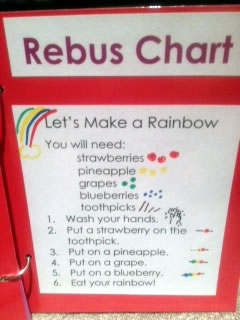
Rebus Charts – Make picture charts for centers so children can follow directions to cook, do art projects, do science experiments, etc.
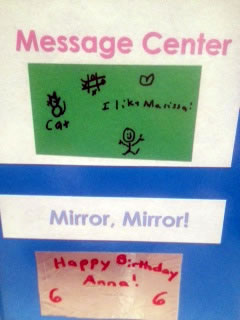
Message Center – Provide a dry erase or chalk board where children can write notes to each other. Children will also enjoy writing sticky notes and posting them around the room.
Mirror, Mirror – Write notes on a classroom mirror with a dry erase marker or Crayola window markers. You could write a birthday message, word, reminder, or special accomplishment.
Sticky Notes – Keep sticky notes handy for reminders, thank you’s, anecdotal notes, etc.